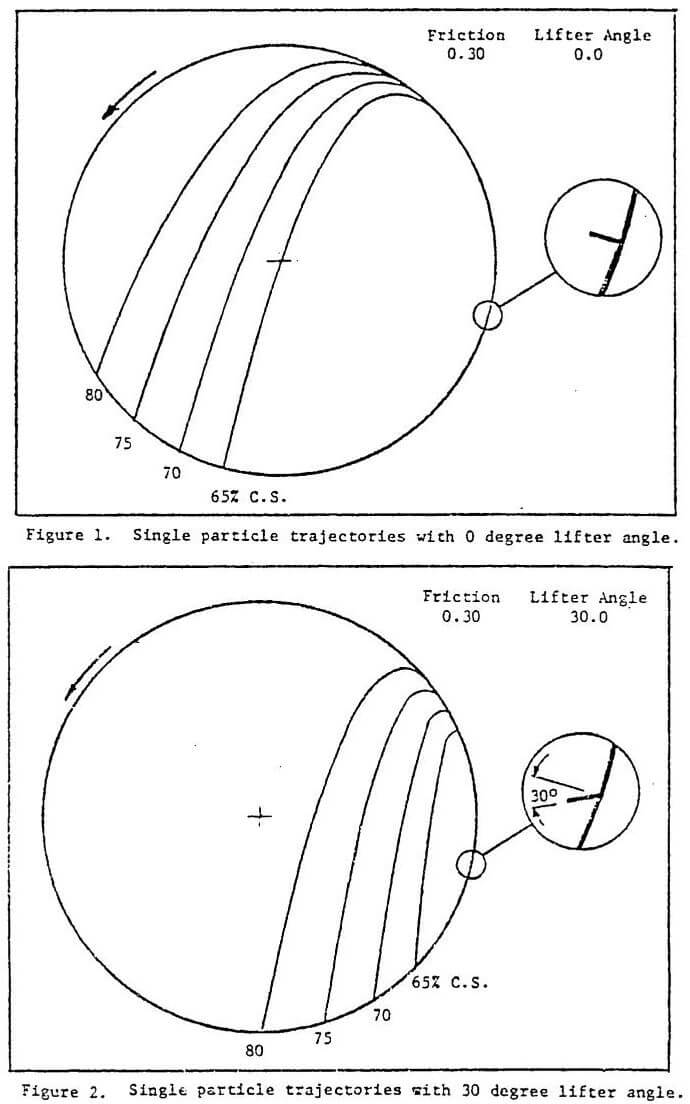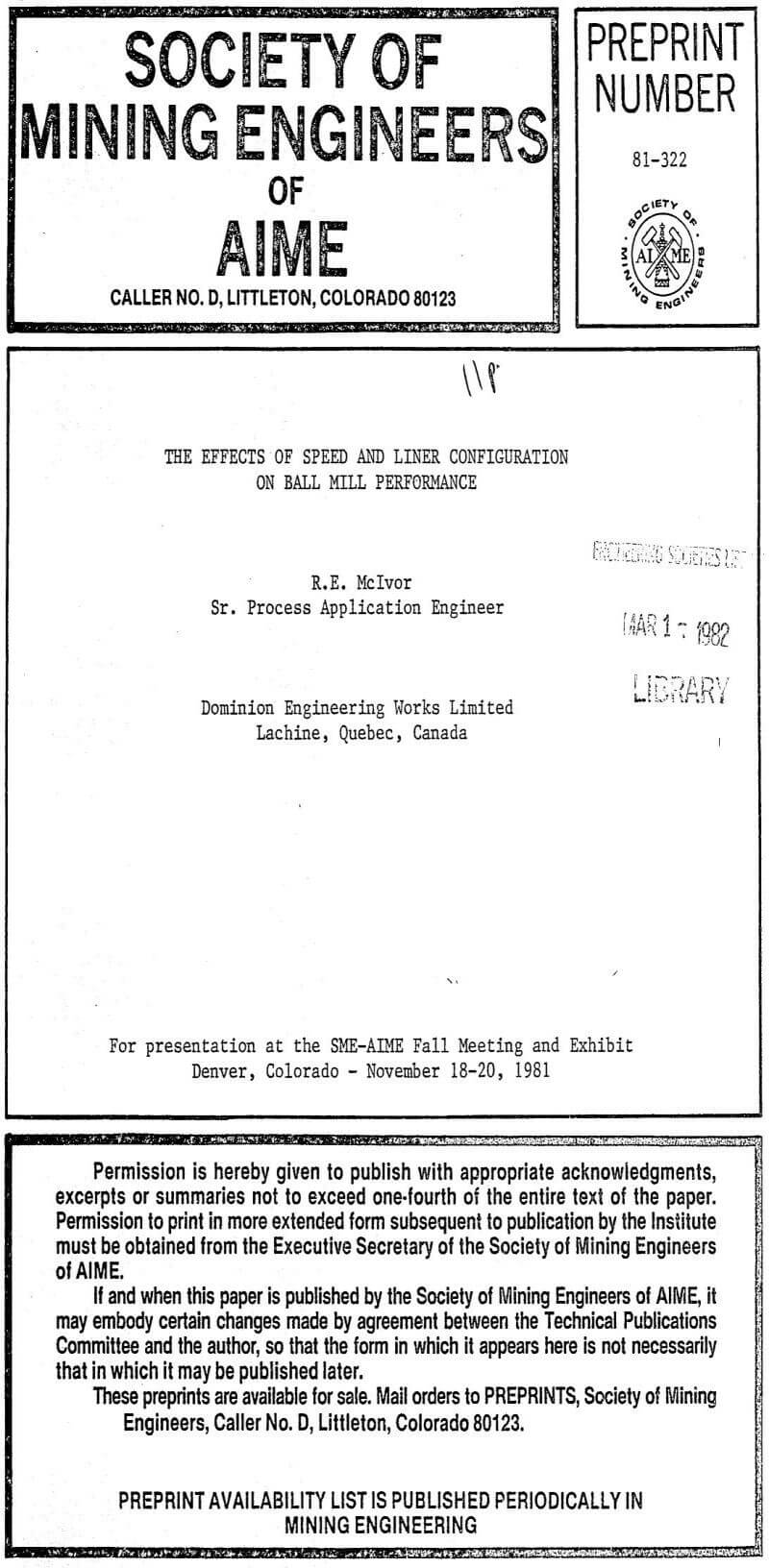The following are factors that have been investigated and applied in conventional ball milling in order to maximize grinding efficiency:
a) Mill Geometry and Speed – Bond (1954) observed grinding efficiency to be a function of ball mill diameter, and established empirical relationships for recommended media size and mill speed that take this factor into account. As well, mills with different length to diameter ratios for a given power rating will yield different material retention times, the longer units being utilized for high reduction ratios, and the shorter ones where overgrinding is of concern. Also related to both material and media retention is the discharge arrangement. South African experience indicates that the faster the pulp removal, the better, as evidenced by the evolution from grates with pulp lifters, to peripheral, and finally, to openend discharge design (Mokken, 1978).
b) Feed Preparation – With more widespread use of coarse ball milling it is increasingly important to present a suitable feed material top-size to the ball mill. Significant inefficiencies are introduced as a result of the need for larger (and, as a result, fewer) grinding balls. Furthermore, as mill performance is related to the complete size distribution of the feed material, all preceeding stages of comminution and classification which influence feed size distribution will have an effect on the performance of the grinding machine.
c) Closed Circuit Grinding – Also closely related to the ability of a ball mill to perform most effectively on a particular material size distribution is the increased grinding efficiency observed with increased circulating load and classifier efficiency. Increased circulating load decreases overgrinding and provides the media with an effectively narrower size distribution to work on. However, it meets with diminishing returns in terms of grinding efficiency and practical limitations are reached due to material handling and classifying requirements.
d) Feed Composition – The feed to the ball mill may contain one or several other constituents besides the ore itself. The most common of these is water, which displays a variety of effects on the grinding process, depending on the nature of the material and the percent solids of the mix. Dry grinding may require ten to fifty percent more power than wet, although this is offset by greatly diminshed media and liner consumption. The introduction of several percent moisture without heated gas sweeping can virtually halt grinding of fine material, until increased water addition carries the material through the sticky stage into the normal wet grinding range of sixty to eighty percent solids by weight. Within this range, an optimum water content for efficient grinding normally exists depending on the combined effects of a number of prevalent conditions such as pulp viscosity, mill retention time, internal friction and filling of the intersticies of the charge, material transport characteristics, and the mill physical design parameters.
e) Media Utilization – Matching the material size distribution with the most effective media size distribution is widely practiced, and involves both the media top size selection, as well as graded ball recharging. The principle that larger balls are better for coarse grinding, and small balls for fine grinding is also applied in the cement industry by media classification inside the mill, either with division heads, ox with the use of classifying liners.
Selection of grinding ball material is usually evaluated in terms of cost effectiveness with respect to media consumption. However, increases in specific gravity and surface hardness have also been reported to have shown significant improvements in grinding energy use, and are definite areas of interest for further study.
f) Control Technology – With few exceptions, a grinding circuit will be faced with changes in feed characteristics that cause the prevailing operating conditions to be continuously digressing from those considered most desirable. Due to the frequency of these variations and the response time and reliability of the human operator, automatic control systems have been applied and have reported energy efficiency improvements of up to fifteen percent, with current research in advanced control strategies holding the promise of even further improvements.

Mechanisms of grinding in a ball mill can be broadly grouped as either impact or attrition with at least two forms of breakage attributable to each type. Impact breakage may occur as a result of a particle being smashed between balls or between a ball and the mill lining, but is also generally defined to include slow compression fracturing, or crushing of particles between grinding media. Whichever the form, impact grinding displays a range of sizes in the product particles, with virtual disappearance of the parent. Attrition grinding includes abrasion, the surface removal of grains by a rubbing action, as well as chipping off of pieces by forces which fail to break the whole particle. Both attrition actions are typified by the production of small daughter particles and the survival of the reduced, but yet identifiable, parent. (Note that the meaning of “attrition” as used here is adapted from the above reference, as opposed to that sometimes used in describing autogenous grinding mechanisms).
The magnitude of the efficiency effect attributable to optimum utilization of grinding mechanisms should not be underestimated. For example, Turner (1979) has demonstrated an overall increase in capacity of almost 800 percent by ball addition to an ore of extreme difficulty to grind in the autogenous mode, and attributes the increased efficiency to both (a) impact action of the balls, and (b) increased usage of abrasion forces on greater surface area created by (a). The same source of synergy found in Turner’s “optimized load” principle can also be applied to ball milling through suitable application of grinding mechanisms in conjunction with the other previously described factors that effect ball mill efficiency. While examples of ball mill efficiency improvements may be far less dramatic, they are none the less as significant in their own realm.
